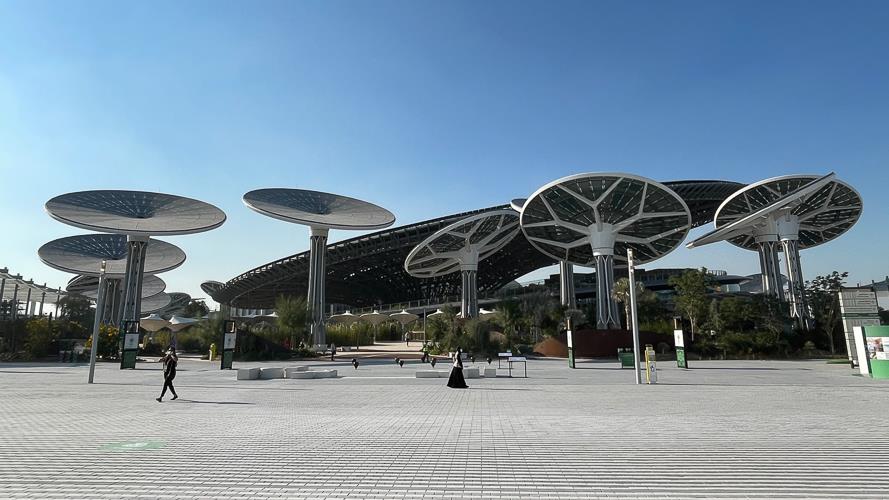

 Expo 2020 champions the UAE's sustainability initiatives
Expo 2020 champions the UAE's sustainability initiatives
The premiere of the sustainability pavilion at the Expo 2020 Dubai site has revealed key visitor experiences.
Called Terra, the pavilion offers an immersive journey through the natural world, kicking off with a walk through time in an Arabian wadi, surrounded by sculptures of elephants, cheetahs and camels. Visitors then enter the space beneath the central canopy, where giant pinball and whack-a-mole machines are situated.

An interactive passage through the roots of a forest shows how every footstep affects the "wood-wide web". In another area of the pavilion, visitors can experience life in the ocean, in chambers echoing with sounds of whales and the heartbeats of octopuses. The dark depths of the ocean are simulated using glimmering blue lights to create an engaging sensory experience.

"[For the design,] we dug deep into the elements of the environment that we forget about," says Marjan Faraidooni, chief pavilions and exhibitions officer at Expo 2020 Dubai. "We wanted to bring this to light for our visitors, uncovering things that make them wonder and appreciate that they are part of this ecosystem."

Illustrating the hidden harmful impacts of our choices, the experience in the pavilion's "consumption halls" is designed to encourage visitors of all ages – and the younger generation in particular – to consider how their behaviour impacts the environment. With interactive exhibits such as Would You Rather, where visitors are asked to choose between two seemingly simple yet thought-provoking options, the aim is to break the cycle of consumerism and empower young people to become agents of change.

A giant consumption machine called Gnasher, shaped like a deep-sea fish, demonstrates how plastics and other consumer products are harmful to the planet.

 Bidding adieu to single-use plastics
Bidding adieu to single-use plastics
“We did not take the traditional approach of telling you what is right or wrong," says Faraidooni. “The entire experience utilises the ‘planetary boundaries’ model that was devised by the Stockholm Resilience Centre. This studies the actions that push the boundaries of the environment. We used this methodology to create a fun, immersive experience for our visitors that simultaneously informs them of the negative impact of our actions."

The pavilion's Laboratory of Future Values houses sustainable solutions to current problems, including vertical hydroponic farms.
"Across the thematic pavilions, our final intention is to make our visitors reflect," says Faraidooni. "We want them to believe they too can be agents of change."
The journey through the pavilion circles back to where it begins, underneath a cascade of shimmering butterflies in the central atrium. Visitors have the option to visit the Terra cafe and gift store, where they can purchase sustainably sourced food, beverages and other goods.

Building design
Designed by UK-based Grimshaw Architects, the 25,000 square-metre pavilion aims to be an example of sustainable building design. Built to be net-zero for both energy and water, it features 1,055 solar photovoltaic panels arranged on a 130 metre-wide roof canopy and on top of a series of ‘energy trees’. The canopy’s slanted angle lowers temperature in the surrounding area.
The pavilion also uses water-reduction strategies, water recycling and alternative water sources. Surrounding the pavilion are a salt-tolerant species of desert plant called halophytes, which aid in filtering water produced from the building.
The sustainability pavilion will be included in the expo legacy project District 2020 after April 2022, as a children’s and science centre.

The Terra pavilion will be open to the public from 22 January to 10 April 2021 with tickets priced at AED25.
Alif, the mobility pavilion, and Mission Possible, the opportunity pavilion, will open later in the first quarter of 2021.

The mobility pavilion will also be retained in the expo's legacy phase, first in its existing form and later as a commercial office space. The opportunity pavilion, which has a temporary building lifespan of five to 10 years, will be dismantled after the event.
You might also like...

Iraq signs deal to develop the Akkas gas field
25 April 2024

Emaar appoints beachfront project contractor
25 April 2024

Acwa Power signs $356m Barka extension
25 April 2024

AD Ports secures Angola port concession agreement
25 April 2024
A MEED Subscription...
Subscribe or upgrade your current MEED.com package to support your strategic planning with the MENA region’s best source of business information. Proceed to our online shop below to find out more about the features in each package.




